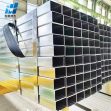The “double carbon” target promotes the decarbonization of steel
In today’s fast-paced world, the quest for sustainable development has become a top priority for nations worldwide. As a key player in the global economy, the steel industry is at the forefront of this movement, striving to reduce its carbon footprint and embrace a more environmentally friendly production process of welded steel pipe.
The “double carbon” target, an international goal to cut down greenhouse gas emissions and reach carbon neutrality, has set off a wave of decarbonization in various sectors, including steel. This target, also known as “carbon peak” and “carbon neutrality,” is expected to drive a fundamental shift in the steel industry’s production and processing methods.
To meet the double carbon target, steel companies worldwide are adopting cleaner production methods, such as using alternative energy sources like solar and wind power. They are also exploring new technologies, such as hydrogen-based steelmaking and direct reduced iron (DRI), which can significantly reduce carbon emissions during production of cold rolled steel pipe.

One of the primary challenges for the steel industry is the high carbon intensity of its production process. Converting iron ore into steel typically requires a high temperature that is primarily generated by burning coal, which releases CO2 into the atmosphere. As a result, the steel industry has been criticized for being a major contributor to global warming.
However, with the double carbon target looming on the horizon, steel companies have been forced to innovate and adopt cleaner production methods. Some companies have started using alternative energy sources like solar and wind power to generate heat during the steelmaking process, reducing reliance on coal. Others are exploring new technologies, such as hydrogen-based steelmaking and direct reduced iron (DRI), which can significantly reduce carbon emissions during production of steel conduit.
The double carbon target is not only beneficial for the environment but also for the steel industry’s competitiveness. As countries worldwide strive to reach carbon peak and carbon neutrality, the demand for low-carbon steel products is expected to increase significantly. This provides an excellent opportunity for steel companies that can adapt quickly to the changing market landscape to gain a competitive edge over their peers.
In conclusion, the double carbon target has presented an opportunity for the steel industry to embrace decarbonization and adopt cleaner production methods. By embracing this challenge, steel pipe manufacturer can not only reduce their carbon footprint but also enhance their product’s marketability and ensure their long-term competitiveness.
Tel: +86 18202256900 Email: steel@fwssteel.com










